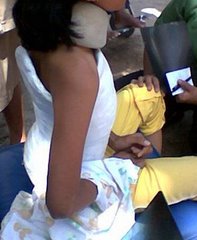Juvenile Rheumatoid Arthritis: Treatment & Medication
Updated: Apr 7, 2010
Treatment
Medical Care
Medical care of children with juvenile rheumatoid arthritis (JRA) must be provided in the context of a team-based approach, considering all aspects of their illness (eg, physical functioning in school, psychological adjustment to disease). Using medications in the absence of an appropriate physical therapy program and attention to problematic social issues of the family is not successful. Success of medications is monitored best with repeated physical examinations and history. Both the number of joints involved and the duration of morning stiffness should demonstrate continued decrease, with elimination reflecting success.
Surgical Care
Surgery is not usually needed; however, some children with persisting pauciarticular juvenile rheumatoid arthritis, despite medical treatment, may benefit from intra-articular steroid injection. Such injections may also be effective in treating temporomandibular arthritis in children with polyarticular juvenile rheumatoid arthritis. Usually, delay joint replacement (often of the hips, in patients with polyarticular juvenile rheumatoid arthritis) until bone growth has completed, which is reflected by epiphyseal closure. The consistent effective use of medical treatment has consigned synovectomy to a rarely used intervention. Large leg length discrepancies may need surgical treatment.
Consultations
The subspecialty team includes the following:
- Pediatric rheumatologist (when available)
- Nurses (who help with education)
- Physical and occupational therapists: Nonmedical approaches (eg, physical and occupational therapy) are an important part of treatment. At presentation, arthritis may be so active as to preclude the use of an aggressive program of muscle strengthening. Nevertheless, the use of pain modalities during this period may permit the gradual introduction of an active program of exercises and stretching.
- Social workers: Social work evaluation helps to determine how well each family is coping with their child's disease in terms of emotional and financial resources. Social workers can offer invaluable guidance for helping children to maintain healthy relationships both within their families and at school. Transition programs for adolescents with arthritis can help prepare them for higher education and future vocations.
Pediatric ophthalmologists help provide slit-lamp examinations to exclude uveitis. Pediatric orthopedic surgeons can offer consultation when orthopedic diagnoses are being considered. The development of profound anemia or a drop in 2 or more cell lines may require the help of a pediatric hematologist. A pediatric gastroenterologist may help with hepatic abnormalities or symptoms suggesting inflammatory bowel disease.
Diet
No specific diet helps in the treatment of juvenile rheumatoid arthritis. However, because active juvenile rheumatoid arthritis has been associated with decreased osteoblastic activity and a risk of osteopenia, encourage the inclusion of at least 3 servings of calcium-rich foods each day. Consider behavioral intervention when poor calcium intake persists.
Activity
Encourage patients to be as active as possible. Except in individuals with severe systemic disease, bed rest is not a part of the treatment. In fact, the more active the patient the better the long-term prognosis is. Children may experience increased pain during routine physical activities. As a result, these children must be allowed to self-limit their activities, particularly during physical education classes. A consistent physical therapy program, with attention to stretching exercises, pain modalities, joint protection, and home exercises, can help ensure that patients are as active as possible.
Medication
Classes of medications are suggested below, and specific drugs are covered in detail by category. See the therapeutic algorithm below
One set of suggested algorithms for the treatment of patients with juvenile arthritis. This should not be considered dogmatic because treatment is not standardized and remains empiric and, at times, controversial.
Nonsteroidal anti-inflammatory drugs (NSAIDs) are used to treat all subtypes of juvenile rheumatoid arthritis (JRA). They may help with pain and decrease swelling. They are often used in conjunction with second-line agents. These medications are effective because of inhibition of prostaglandin synthesis. Naproxen is listed below as an example of an NSAID used in treatment; other NSAIDs commonly used include ibuprofen, tolmetin, diclofenac, and indomethacin. In addition, sulfasalazine is sometimes used as a second anti-inflammatory drug in some children with persisting pauciarticular and polyarticular disease. Its use may be considered as an intermediate step prior to adding a second-line drug such as methotrexate (MTX).
Aspirin is no longer the drug of first choice because of the increased frequency of gastric toxicity and hepatotoxicity when compared to other NSAID medications, along with its association with Reye syndrome. The discovery that cyclooxygenase (COX) in gastric and intestinal endothelium (ie, COX-1) is different in structure from that in leukocytes (ie, COX-2) has led to the development of anti-inflammatory drugs specific for COX-2. COX-2 inhibitors have been found to be effective in treatment of adults with rheumatoid arthritis. Studies of COX-2 inhibitors in persons with juvenile idiopathic arthritis are underway. Besides the benefit of greatly reducing gastric toxicity (although hepatotoxicity remains a possible adverse event), COX-2 inhibitors do not inhibit platelet aggregation. Thus, these agents may find a role in the treatment of inflammatory conditions in which a bleeding diathesis is a potential problem, such as in the postoperative setting.
NSAIDs alone are usually adequate for treatment of pauciarticular disease. However, an aggressive arthritis sometimes develops in this subtype, requiring the need to add a second-line drug. Various second-line drugs have been used in addition to first-line NSAIDs. Gold salt injections were used until approximately 15 years ago, when studies by the Pediatric Rheumatology Collaborative Study Group demonstrated the efficacy of oral (PO) MTX; these injections are not currently used for most children. Subsequent studies have demonstrated that some children with polyarticular arthritis unresponsive to PO MTX benefit from subcutaneous (SC) or intramuscular (IM) administration. The use of high-dose intravenous (IV) steroids as a therapeutic bridge in selected patients has been beneficial in some patients, particularly during an early period before MTX may have a full therapeutic effect.
Etanercept, a biologic agent administered SC twice weekly and containing a receptor to tumor necrosis factor (TNF) ligated to an Fc portion of immunoglobulin, has been found to be effective in controlling polyarticular arthritis not controlled by conventional medical treatment. Adalimumab is another anti-TNF agent now approved for use in juvenile idiopathic arthritis. These medications are for those children treated by pediatric rheumatology centers who are unresponsive to treatment including conventional second-line drugs.
Abatacept is a biological immune modulator with a delayed onset of action (4 mo) that may be useful in polyarticular disease.
Finally, the treatment of systemic juvenile idiopathic arthritis may require, in addition to treatment with NSAIDs, the careful use of either PO or high-dose pulse IV corticosteroids. Such treatment is best reserved for patients in whom definite arthritis has developed to avoid premature treatment in a patient who may prove to have a disease other than juvenile rheumatoid arthritis. Corticosteroids may be avoided with the use of anakinra, which is relatively new, inhibits interleukin (IL)-1 activity, and appears to have unique efficacy on the systemic signs and symptoms of systemic juvenile idiopathic arthritis. Rilonacept (anti-IL-1) may be an alternative treatment that is being studied, as is tocilizumab, which is anti-IL-6. Thalidomide has also been reported to be useful in these children.









1 comment:
Excellent Article... thanks..
Post a Comment